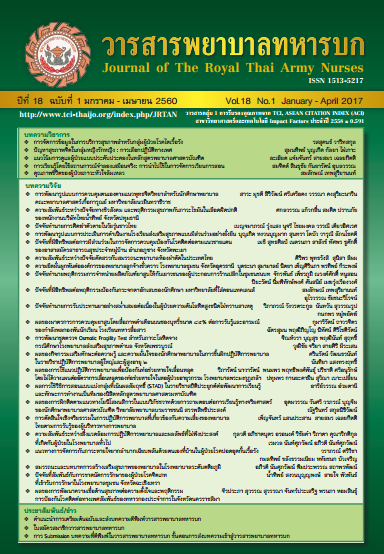ความสัมพันธ์ระหว่างปัจจัยทางชีวสังคม และพฤติกรรมสุขภาพกับ ภาวะไขมันในเลือดผิดปกติ ของพนักงานบริษัทไทยน้ำทิพย์ จังหวัดปทุมธานี
Keywords:
ปัจจัยทางชีวสังคม, พฤติกรรมสุขภาพ, ความสัมพันธ์, ภาวะไขมันในเลือดผิดปกติ, bio-social factors, health behaviors, association, dyslipidemiaAbstract
การศึกษาวิจัยนี้มีวัตถุประสงค์ เพื่อศึกษาความสัมพันธ์ระหว่างปัจจัยทางชีวสังคม และพฤติกรรมสุขภาพกับภาวะไขมันในเลือดผิดปกติ ใช้รูปแบบการวิจัยเชิงวิเคราะห์ (Observational Analytic studies) การศึกษาชนิด Unmatched case-controlstudy ศึกษากับพนักงานบริษัทไทยน้ำทิพย์ จังหวัดปทุมธานี จำนวน 324 คน จำแนกเป็น กลุ่มศึกษา 162 คน และกลุ่มควบคุม162 คน เก็บรวบรวมข้อมูลด้วยแบบสอบถาม วิเคราะห์ข้อมูลด้วยสถิติเชิงพรรณนา (Descriptive statistics) ได้แก่ ค่าความถี่ร้อยละ และสถิติเชิงอนุมาน (Inferential statistics) โดยใช้การทดสอบไคแสควร์ (Chi-square test) อัตราความเสี่ยง(Odds ratio) และวิเคราะห์การถดถอยพหุลอจิสติก (Multiple logistic regression)ผลการศึกษาพบว่าปัจจัยทางชีวสังคม และพฤติกรรมสุขภาพที่มีความสัมพันธ์กับภาวะไขมันในเลือดผิดปกติของพนักงานบริษัทไทยน้ำทิพย์ จังหวัดปทุมธานี ประกอบด้วยปัจจัยเสี่ยง ได้แก่ ค่าดัชนีมวลกาย ≥ 25 กิโลกรัม/ตารางเมตร (ORadj = 3.27, [95%CI: 1.84-5.84], p < 0.001) มีความเสี่ยงต่อภาวะไขมันในเลือดผิดปกติ มากกว่าค่าดัชนีมวลกาย 18.5-22.9 กิโลกรัม/ตารางเมตร การพบแพทย์เพื่อตรวจสุขภาพร่างกาย 1 ครั้งต่อปี (ORadj = 3.21, [95%CI: 1.58-6.52], p = 0.001) และ 2 ครั้งต่อปี (ORadj = 4.96, [95%CI: 1.27-19.36], p = 0.021) มีความเสี่ยงต่อภาวะไขมันในเลือดผิดปกติมากกว่าพนักงานที่ไปตรวจสุขภาพประจำปีมากกว่า 2 ครั้งขึ้นไป และปัจจัยป้องกัน ได้แก่ สถานภาพโสด (ORadj = 0.32, [95% CI: 0.11-0.89], p = 0.029) และสถานภาพหย่า/หม้าย (ORadj = 0.42, [95% CI: 0.18-0.98], p = 0.045) มีโอกาสเกิดภาวะไขมันในเลือดผิดปกติลดลงกว่าสถานภาพสมรส และอยู่ร่วมกัน
Association between Bio-social Factors and Health Behaviors with Dyslipidemia among Employees of Thai Nam Thip Company at Changwat Pathum Thani
This research was aimed to study the association between bio-social factors and health behaviors with dyslipidemia. Observational analytic studies with unmatched case-control study were conducted 324 employees of Thai Nam Thip company at Changwat Pathum Thani. The subjects were divided into 162 cases and 162 controls. Data was collected by a questionnaire, was analyzed by descriptive statistics, including mean, standard deviation and percentages and inferential statistics using chi-square test, odds ratio, and multiple logistic regression. The study found that the bio-social factors and health behaviors associated with dyslipidemia. Risk factors of dyslipidemia include: body mass index ≥ 25 Kg / m2 (ORadj = 3.27, [95% CI: 1.84-5.84], p < 0.001) was risk more than body mass index18.5-22.9 Kg / m2. Physical checkup: 1 time/year. (ORadj = 3.21, [95% CI: 1.58-6.52], p = 0.001) and physical checkup: 2 times/year (ORadj = 4.96, [95% CI: 1.27-19.36], p = 0.021) were risk more than physical checkup: more 2 times/year. Then protective factors include single (ORadj = 0.32, [95% CI: 0.11-0.89], p = 0.029) and divorced/widowed (ORadj = 0.42, [95% CI: 0.18-0.98], p = 0.045) were chance of dyslipidemia reduction than married and live together.
Downloads
Downloads
How to Cite
Issue
Section
License
บทความหรือข้อคิดเห็นใดใดที่ปรากฏในวารสารพยาบาลทหารบกเป็นวรรณกรรมของผู้เขียน ซึ่งบรรณาธิการหรือสมาคมพยาบาลทหารบก ไม่จำเป็นต้องเห็นด้วย
บทความที่ได้รับการตีพิมพ์เป็นลิขสิทธิ์ของวารสารพยาบาลทหารบก
The ideas and opinions expressed in the Journal of The Royal Thai Army Nurses are those of the authors and not necessarily those
of the editor or Royal Thai Army Nurses Association.






